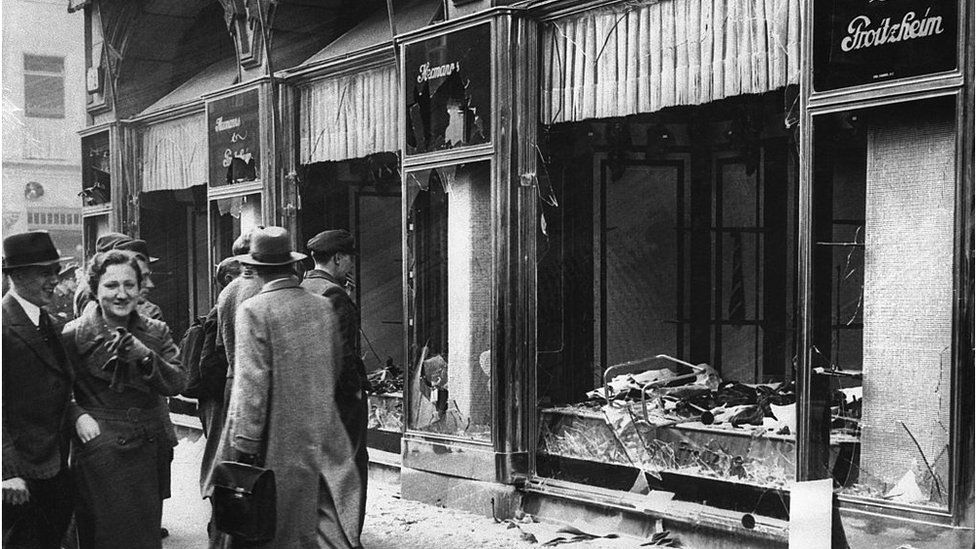-

-
-
Loading

Loading

A group of 50 or 60 people mock a Jewish shopkeeper as he tries to remove anti-Semitic graffiti from the pavement. Hats and broken glass are scattered on the road outside a destroyed Jewish-owned hat shop. These are the scenes witnessed by six-year-old George Shefi outside his Berlin home after the Nazi pogroms in November 1938. George, now 92 years old and living in Israel, recounts the memory of the destruction vividly. As a child, he fled Nazi Germany without his parents and was one of approximately 10,000 mostly Jewish children evacuated to the UK in what is now known as the British Kindertransport program. George has returned to Berlin to retrace his journey of escape and commemorate the 85th anniversary of the pogroms. He recalls the destruction of shops near his home and the burning of his school, which was connected to a synagogue. At the time, George was unaware that this violence was taking place throughout Germany and that his life was about to change forever. On the night of November 9, 1938, Nazi mobs rampaged across the country, destroying Jewish-owned businesses and burning nearly all of Germany's synagogues. The pogrom, also known as Kristallnacht, resulted in the deaths of 91 Jews and the sending of 30,000 Jewish men to concentration camps. George's mother, Marie, made the painful decision to send George to safety in the UK after witnessing these events. The pogroms marked a turning point in Hitler's persecution of the Jews, with German Jews realizing for the first time that they were not safe. Families who were able to do so, fled the country in an effort to protect their children. After securing a place for George on the Kindertransport, Marie prepared him for his journey, making it sound like an adventure. In reality, the children were only allowed to take a small sealed suitcase with essential items. Marie accompanied George to Berlin's Friedrichstrasse station, where he boarded a train filled with other children seeking refuge. George remembers the heart-wrenching sight of parents saying goodbye to their kids and the difficulty his mother had in finding him in the crowded train. Little did George know that this would be the last time he would see his mother alive. Marie was later taken to Auschwitz concentration camp and murdered shortly after her arrival. The Kindertransport program was supported by the British government but relied heavily on NGO funding, donations, and volunteers. Visas were waived for the children but not for their parents, leading to the deaths of many parents in the Holocaust. Arriving in England was traumatic for the children as they were selected by foster families they had never met and who spoke a language they didn't understand. The foster family matching process resembled a cattle market, with young, blond, and blue-eyed children being favored. Oversight of foster families was lacking, and some of the children experienced emotional and physical abuse. George has returned to Berlin to share his story and ensure that history is not forgotten or repeated. He visits the site of his former school, which now has a wall of memorial stones honoring Jewish people who were killed in the Holocaust, including his mother. During his visit, George speaks to a class of 11-year-old German schoolchildren about his life. The students are moved by the story, with one student expressing compassion for a mother who had to say goodbye to her child. The children present George with a small box containing a fragment of tile, a remnant of his burned-down school. George and two other survivors are retracing their childhood journey, traveling by boat and train from Germany to London's Liverpool Street train station, where the Kindertransport children were received by foster families or relatives. The organizers of this trip, such as Scott Saunders from the Holocaust education charity March of the Living UK, believe that events like this are crucial in the current climate of rising antisemitism and hatred. They aim to stand up against discrimination and ensure that the phrase "never again" truly means never again. Despite enduring the trauma of loss and separation, George considers himself fortunate. He acknowledges the kindness of the people who helped him, the support of his foster family, and the fact that he has reached the age of 92. George and his family have made multiple trips to Berlin to share their story and ensure that history is not forgotten. They have a tradition of taking a photo of George in the same spot where he was photographed as a young boy before the events unfolded. These photos serve as a reminder of his resilience and how far he has come, with his children, grandchildren, and great-grandchildren representing his ultimate victory over Hitler.